Orange peel soap offers powerful skin benefits through natural exfoliation and vitamin C. You'll need a soap base, dried orange peel powder, orange essential oil, and optional additives like vitamin E or aloe vera gel. For beginners, try the melt-and-pour method—simply melt the base, add your ingredients, and pour into molds. The cold process technique requires more time but creates more nourishing bars. Proper ingredient preparation and storage techniques guarantee your homemade citrus soap maintains its revitalizing qualities.
The Health Benefits of Orange Peel for Skin Care
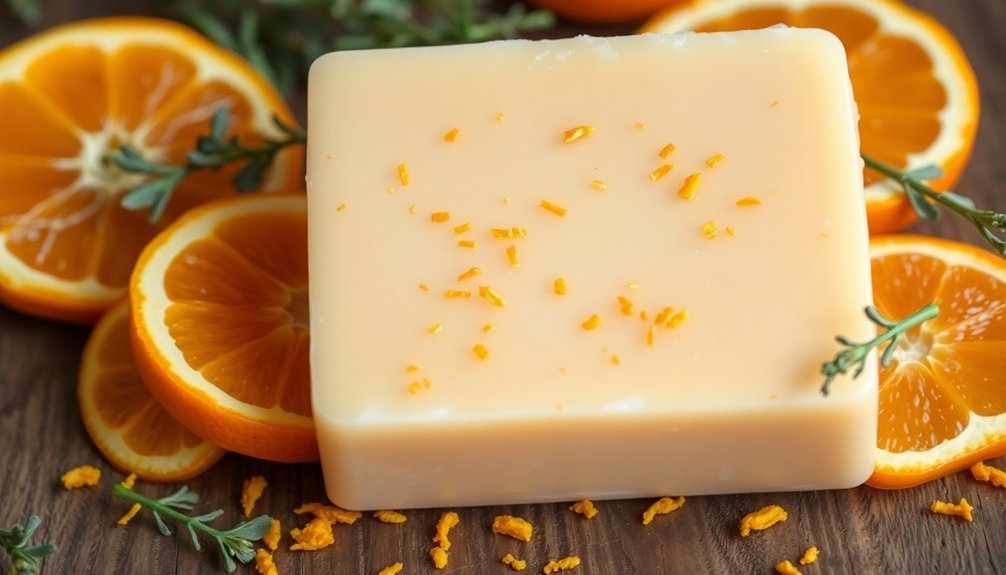
While many people discard orange peels after enjoying the fruit, these often-overlooked rinds offer remarkable benefits for your skin.
Orange peels are packed with antimicrobial compounds that fight acne-causing bacteria and anti-inflammatory properties that soothe irritation and redness.
The powerful antimicrobial and anti-inflammatory properties in orange peels effectively combat acne while calming irritated skin.
The citric acid in orange peels brightens your complexion by reducing dark spots and pigmentation. As a natural exfoliant, orange peel removes dead skin cells while unclogging pores and eliminating blackheads.
You'll also benefit from its vitamin C content, which stimulates collagen production for firmer, more youthful skin. Regular use helps fade acne marks and improves overall skin clarity with consistent application.
Orange peel's antioxidants combat free radicals that cause premature aging, while its natural astringent properties tighten pores and balance oil production.
For hydration, the vitamins and antioxidants help retain moisture, leaving your skin soft and radiant.
Essential Ingredients for Orange Peel Exfoliating Soap
Creating homemade orange peel soap starts with gathering the right ingredients. Your soap's effectiveness depends on combining exfoliating elements with moisturizing components that work together to rejuvenate your skin. The process benefits from rhythmic stirring, similar to how consistent rhythm establishes cohesion in musical performances.
- Soap Base – Choose a high-quality melt and pour base for ease of use, serving as the foundation for your homemade creation.
- Orange Materials – Incorporate dried orange peel powder or slices for natural exfoliation and skin-brightening properties.
- Essential Oils – Add orange essential oil for fragrance, with optional bergamot or cedarwood for depth and additional benefits.
- Moisturizing Agents – Include Vitamin E oil or aloe vera gel to balance the exfoliation with hydration, preventing skin dryness.
Don't forget supplementary exfoliants like coffee grounds or sugar for enhanced scrubbing power.
Step-By-Step Cold Process Soap Making With Orange Peel Powder
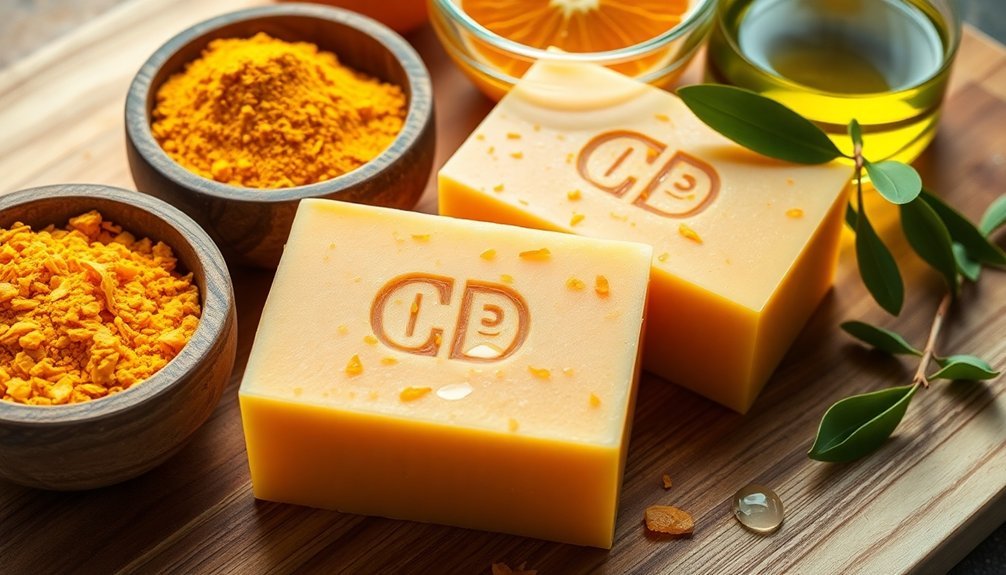
The cold process method transforms orange peel powder into luxurious, skin-nourishing soap bars through careful chemical reactions and artful technique.
Humble orange peels, through the alchemy of cold process soapmaking, become treasured skincare companions rich in natural goodness.
Before beginning, verify you've prepared properly dried and finely sifted orange peel powder.
Start by combining your lye with distilled water while wearing protective gear. Once cooled to a safe temperature, mix with your oils.
You can add the orange peel powder at different stages: directly to the lye solution for smoothness, infused into oils beforehand for better dispersion, or at trace for a speckled, exfoliating effect.
The general recommendation is to use 1 teaspoon PPO adjusted according to your specific recipe weight.
Pour your mixture into molds and allow 24-48 hours for setting. For best results, cure the soap for 4-6 weeks.
Using sodium lactate in your lye water creates harder bars, while organic orange peels verify your soap remains free from pesticides.
Melt and Pour Method: Quick Orange Peel Soap for Beginners
You'll find the melt and pour soap method incredibly accessible, requiring just a soap base, orange peel, and essential oils to create beautiful soaps in under an hour.
This beginner-friendly technique bypasses the need for lye handling while still letting you infuse your creations with orange peel's natural exfoliating and antimicrobial benefits.
Your skin will thank you for the antioxidant-rich citrus properties that help detoxify and promote a healthier, glowing complexion. Remember to use orange essential oil rather than fragrance oil to ensure maximum therapeutic benefits and effectiveness in your homemade soap.
Easy DIY Process
Making your own orange peel soap at home becomes remarkably simple when you use the melt and pour method. The process requires minimal equipment and you'll have beautiful, fragrant soap bars ready in under an hour.
- Melt your soap base in a microwave or double boiler using short intervals until it's completely smooth, being careful not to overheat.
- Stir in your additives once melted – orange essential oil for fragrance, dried orange peel powder for exfoliation, and optional vitamin E or aloe vera for extra skin benefits. Allow the melted soap to cool for 1-2 minutes before adding your essential oil mixture.
- Pour the mixture into silicone molds and spritz with rubbing alcohol to remove any air bubbles that form on the surface.
- Allow to cool completely before gently removing from molds, typically 30-60 minutes depending on size.
Skin Benefits Overview
Beyond the simplicity of preparation, orange peel soap offers remarkable benefits for your skin. The high concentration of vitamin C—even higher than in the fruit itself—promotes collagen production for firmer, more youthful skin while fighting free radicals that cause premature aging.
When you use orange peel soap regularly, you'll notice its natural exfoliating action from citric acid brightens your complexion by removing dead skin cells. Its antibacterial properties help combat acne and excess oil, while natural oils provide necessary moisture for dry skin. The deep hydration properties help maintain soft and smooth skin texture throughout the day.
The soap works wonders on dark spots and uneven skin tone, gently lightening problem areas. It's generally suitable for sensitive skin since it lacks harsh chemicals, and the invigorating citrus scent offers an added mood-boosting benefit during your skincare routine.
Troubleshooting Common Issues When Making Orange Peel Soap
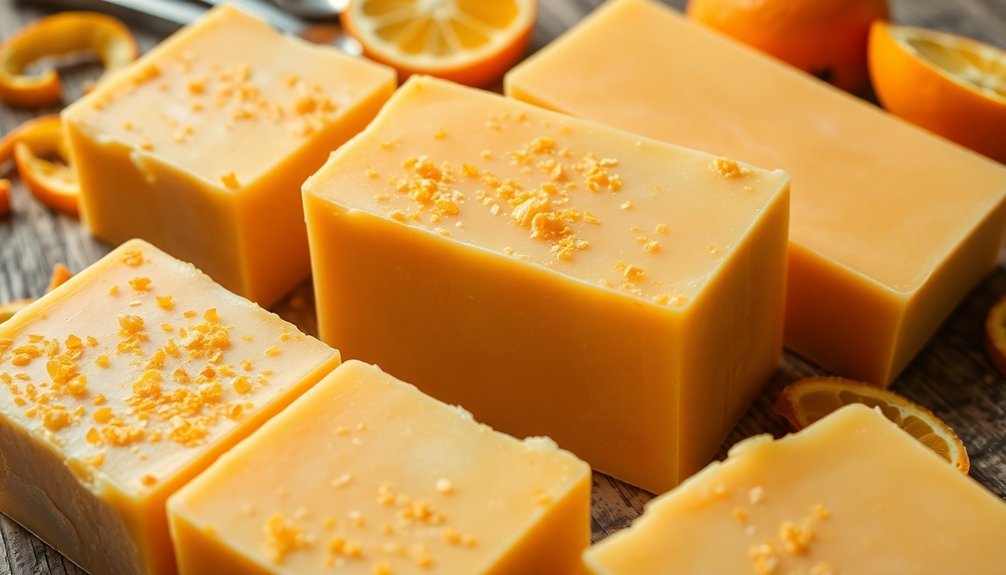
You'll encounter a few challenges when making orange peel soap, but they're all manageable with the right approach.
If you notice mold growing in your soap, you likely didn't dry your orange peels completely before incorporating them into your recipe. Dehydrating peels before adding them to your soap mixture is an effective prevention method for spoilage issues.
When your soap has uneven texture or a fading citrus scent, try using finer ground peels and increasing your essential oil concentration slightly.
Preventing Mold Growth
When crafting orange peel soap, preventing mold growth stands as one of the most vital challenges you'll face. Proper preparation of your orange peels is imperative—they must be thoroughly dried before incorporation to eliminate moisture that feeds mold spores.
- Dry ingredients properly – Use air drying or a low-temperature oven to remove all moisture from orange peels, and store in airtight containers away from humidity.
- Add natural preservatives – Incorporate grapefruit seed extract, tea tree oil, or Preservative Eco to inhibit microbial growth.
- Control your environment – Make soap in well-ventilated areas with low humidity, and make certain all equipment is completely dry. Maintaining humidity levels below 50% with a dehumidifier will significantly reduce the risk of mold developing in your soap-making workspace.
- Use distilled water – Replace tap water with distilled or boiled water to reduce contaminants that contribute to mold formation.
Fixing Uneven Texture
Uneven texture in orange peel soap can frustrate even experienced soap-makers, often resulting from improper ingredient distribution or temperature fluctuations during the curing process.
To achieve consistent results, focus on thoroughly homogenizing your mixture before pouring it into molds. This approach helps prevent the formation of enlarged pores and rough patches in your final soap product.
Ensure you're measuring ingredients with precision—especially the lye-to-oil ratio, which directly impacts texture.
Reduce moisture content for firmer bars, and pay close attention to temperature during saponification. Proper molding techniques also help eliminate air pockets that cause surface irregularities.
If your orange peel exfoliants are creating texture issues, try grinding them to a uniform size and distributing them evenly throughout your soap base.
Finally, use gentle tamping after pouring to release trapped air bubbles before the soap sets.
Adjusting Citrus Scent
The vibrant aroma of orange peel soap often fades during the curing process, leaving many crafters disappointed with their final product. This happens because citrus oils are naturally volatile and quick to evaporate, but you can overcome this challenge with the right techniques.
- Use 5x or 10x folded orange essential oil instead of regular essential oil – these concentrated versions retain their scent considerably longer in soap.
- Add your fragrance oils at lower temperatures and later in the process to prevent premature scent loss.
- Consider incorporating natural preservatives that complement and stabilize citrus scents.
- Increase the amount of essential oil if you're finding the scent too faint, but monitor closely as some citrus oils can cause soap to seize.
For maximum citrus impact, consider adding both the lemon and orange peel granules at trace as specified in the recipe to provide visual appeal and additional natural scent.
Storage Tips and Shelf Life of Homemade Citrus Soaps
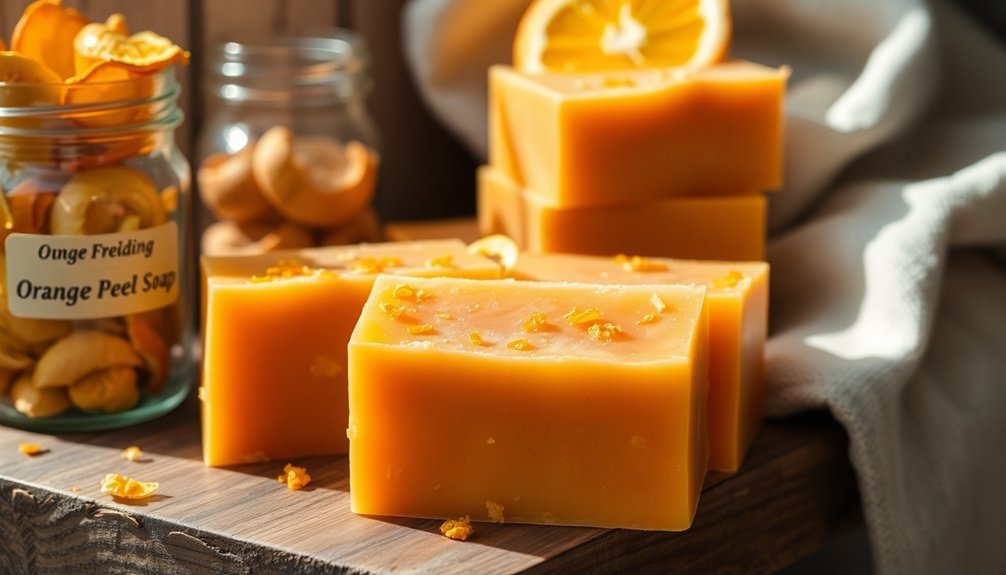
Properly storing your homemade orange peel soap greatly extends its shelf life and preserves its beneficial properties.
Cold process soaps need 4-6 weeks to cure in a cool, dry place with good air circulation. Flip them regularly to prevent bowing and guarantee even drying. This curing process creates harder, longer-lasting bars that are gentler on your skin.
For melt and pour orange soaps, wrap them immediately to prevent glycerin dew, and keep them away from direct sunlight to avoid color fading.
Don't store any citrus soaps in airtight containers as trapped moisture can cause DOS (Dreaded Orange Spots) or rancidity.
Use ventilated trays, wooden racks, or repurposed baker's racks for ideal storage.
When stored correctly, your orange peel soaps will maintain their energizing scent and exfoliating qualities longer, with cold process varieties typically outlasting melt and pour options.
Frequently Asked Questions
Can I Use Dried Orange Peels From Store-Bought Oranges?
Yes, you can use dried orange peels from store-bought oranges. Just make sure they're thoroughly cleaned to remove pesticides. Organic oranges are your best choice to avoid chemical residues in your final product.
How Often Should Orange Peel Soap Be Used on Sensitive Skin?
For sensitive skin, you shouldn't use orange peel soap daily. Limit usage to 2-3 times weekly or bi-weekly. Always apply gently, follow with moisturizer, and adjust frequency based on how your skin responds.
Will Orange Peel Soap Stain My Washcloths or Bathroom Surfaces?
Orange peel soap generally won't stain your washcloths or bathroom surfaces if you rinse thoroughly after use. For extra protection, keep the soap on a dish and wipe up any residue promptly.
Can I Add Orange Peel Soap to a Liquid Soap Dispenser?
Yes, you can add orange peel soap to a liquid dispenser if it's properly liquefied. Verify the peel particles are fine enough to prevent clogging and consider using a dispenser with a wider valve opening.
Is Orange Peel Soap Safe to Use on Colored or Treated Hair?
Orange peel soap isn't recommended for colored hair. The citric acids may strip dye and damage treated hair. You're better off using specialized color-safe products that won't fade or alter your hair color.
In Summary
Now you're equipped to create beautiful, skin-nourishing orange peel soap at home! Whether you've chosen the traditional cold process or beginner-friendly melt and pour method, you'll enjoy the exfoliating benefits and uplifting citrus aroma. Don't forget to properly cure and store your creations to preserve their qualities. With practice, you'll master this natural skincare craft, creating gifts that friends and family will love!

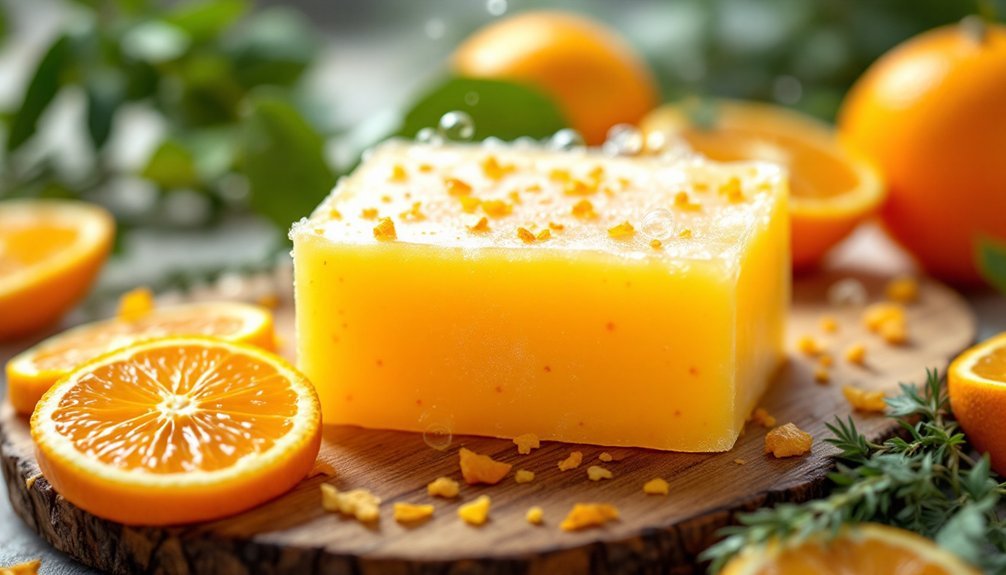



Leave a Reply